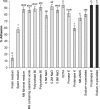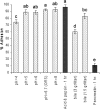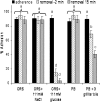Mechanisms involved in governing adherence of Vibrio cholerae to granular starch
- PMID: 20023099
- PMCID: PMC2820958
- DOI: 10.1128/AEM.01533-09
Mechanisms involved in governing adherence of Vibrio cholerae to granular starch
Abstract
Vibrio cholerae has been shown to adhere to cornstarch granules. The present work explored the mechanisms involved in this adhesion and the possibility of its occurrence in vivo. The findings suggest that both specific and nonspecific interactions are involved in the adhesion. Nonspecific hydrophobic interactions may play a role, since both V. cholerae and cornstarch granules exhibited hydrophobic properties when they were tested using a xylene-water system. In addition, the presence of bile acids reduced the adhesion. The adhesion also involves some specific carbohydrate-binding moieties on the cell surface, as reflected by reduced adhesion following pretreatment of the bacteria with proteinase K and sodium m-periodate. Further investigations supported these observations and showed that media containing low-molecular-weight carbohydrates had a significant inhibitory effect. Binding cell lysate to starch granules and removing the adhered proteins using either glucose or bile acids led to identification (by liquid chromatography-tandem mass spectrometry analysis) of several candidate V. cholerae outer membrane-associated starch-binding proteins. Different sets of proteins were isolated by removal in a glucose solution or bile acids. When the upper gastrointestinal tract conditions were simulated in vitro, both bile salts and the amylolytic activity of the pancreatic juices were found to have an inhibitory effect on the adherence of V. cholerae to starch. However, during acute diarrhea, this inhibitory effect may be significantly reduced due to dilution, suggesting that adhesion does occur in vivo. Such adhesion may contribute to the beneficial effects observed following administration of granular starch-based oral rehydration solutions to cholera patients.
Figures





References
-
- An, Y. H., R. B. Dickinson, and R. J. Doyle. 2000. Mechanisms of bacterial adhesion and pathogenesis of implant and tissue infections, p. 1-28. In Y. H. An and R. J. Friedman (ed.), Handbook of bacterial adhesion: principles, methods and applications. Humana Press Inc., Totowa, NJ.
-
- Ausubel, F. M., R. Brent, R. E. Kingston, D. D. Moore, J. G. Seidman, J. A. Smith, and K. Struhl. 1999. Short protocols in molecular biology. John Wiley & Sons, Inc., New York, NY.
Publication types
MeSH terms
Substances
LinkOut - more resources
Full Text Sources
Molecular Biology Databases

